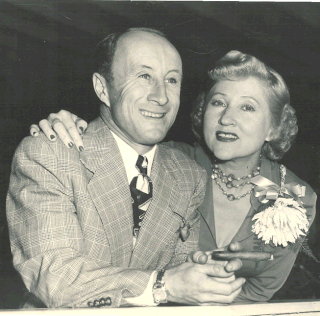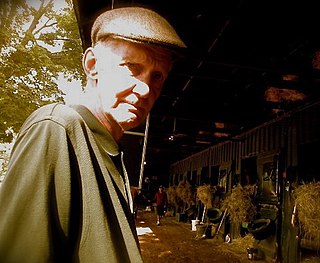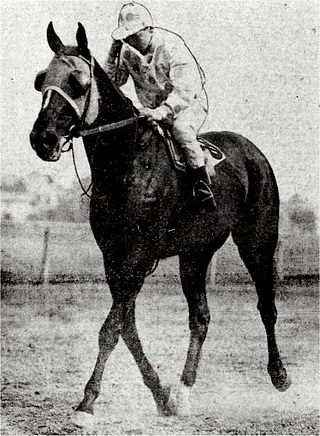Greentree Stable, in Red Bank, New Jersey, was a major American thoroughbred horse racing stable and breeding farm established in 1914 by Payne Whitney of the Whitney family of New York City. Payne Whitney operated a horse farm and stable at Saratoga Springs, New York with his brother Harry Payne Whitney, who also had a large stable of horses. Greentree Stable had a training base at Aiken, South Carolina, while Greentree Farm in Lexington, Kentucky was established in 1925 as its breeding arm.

James Stout was an American Hall of Fame thoroughbred horse racing jockey who won four Triple Crown races.

William H. Turner Jr. was an American Thoroughbred flat racing trainer best known for winning the United States Triple Crown of Thoroughbred Racing in 1977 with Seattle Slew.
Wheatley Stable was the nom de course for the thoroughbred horse racing partnership formed by Gladys Mills Phipps and her brother, Ogden Livingston Mills. The horses were raised at Claiborne Farm near Paris, Kentucky.
High Quest (1931–1948) was an American Thoroughbred racehorse best known for winning the 1934 Preakness Stakes, the second leg of the U.S. Triple Crown series of races.
Cavalcade (1931–1940) was an American Hall of Fame Champion Thoroughbred racehorse. In a career which lasted from 1933 until 1936 he ran twenty-two times and won eight races. He was best known for his performances as a three-year-old in 1934 when his wins included the Kentucky Derby, the American Derby, and the Arlington Classic. His subsequent career was disappointing and he failed to make a significant impact in a brief stud career.

Joseph A. Notter was an American Hall of Fame Champion jockey and winner of two of the American Classic Races.
Edward Riley Bradley was an American steel mill laborer, gold miner, businessman and philanthropist. As well as a race track proprietor, he was the preeminent owner and breeder of Thoroughbred racehorses in the Southern United States during the first three decades of the 20th century. Testifying before a United States Senate committee in April 1934, Bradley identified himself as a "speculator, raiser of race horses and gambler". He appeared on the cover of Time magazine on May 7, 1934. In the year 2000, the Florida Department of State honored him as one of their Great Floridians.

Peter Pan (1904–1933) was an American Thoroughbred racehorse and sire, bred and raced by prominent horseman, James R. Keene. As winner of the Belmont Stakes, the Brooklyn Derby and the Brighton Handicap, he was later inducted into the National Museum of Racing and Hall of Fame. His progeny included many famous American racehorses, including several winners of the Kentucky Derby and the Preakness Stakes.
Mary Elizabeth Whitney Person Lunn Tippett was a wealthy American socialite and philanthropist who was a champion horsewoman and for more than fifty years, a prominent owner/breeder of Thoroughbred racehorses.
Coventry was an American Thoroughbred racehorse best known for winning the 1925 edition of the Preakness Stakes.
Victorian (1925–1934) was an American Thoroughbred racehorse that was bred in Kentucky. He was bred and raced by Harry P. Whitney and is best known as the winner of the 1928 Preakness Stakes in which he was ridden by future Hall of Fame jockey Sonny Workman.
Flying Ebony (1922–1943) was an American Thoroughbred racehorse best known for winning the 1925 Kentucky Derby.
Double Jay (1944–1972) was an American Thoroughbred racehorse. Bred by John W. Stanley in Lexington, Kentucky, he was purchased as a yearling for $19,000 by Wilmington, Delaware businessmen James V. Tigani and James Boines who raced them under their newly formed partnership, Ridgewood Stable.
Thomas J. Healey was an American Thoroughbred horse racing Hall of Fame trainer.

Pompey (1923–1944) was an American Champion Thoroughbred racehorse.
Flying Heels (1927–1940) was an American Thoroughbred racehorse that won stakes races at age two through six, including a number which are Grade I events today. Bred and raced by Gifford A. Cochran, he was sired by the 1925 Kentucky Derby winner, Flying Ebony and out of the racemare Heeltaps.
The Empire City Derby was an American Thoroughbred horse race held annually from 1917 through 1933 at Empire City Race Track in Yonkers, New York. A race for three-year-old horses of either sex, the event was contested at a mile and one-eighth at inception until 1920 when it was set at what became known as the "Derby distance" of a mile and one-quarter. With the Brooklyn Derby at Belmont Park having changed its name to the Dwyer Stakes, the Empire City Derby was then the only Derby event in the Northeastern United States.
The Eastern Shore Stakes was an American Thoroughbred horse race run between 1913 and 1949 at Havre de Grace Racetrack, in Havre de Grace, Maryland. A race for two-year-old horses of either sex, it was inaugurated and run for most of its existence as the Eastern Shore Handicap.
William Lloyd Kelsay was one of the top jockeys in American Thoroughbred racing during the 1920s who was widely respected for his ability to handle two-year-old horses during their first year of racing.




